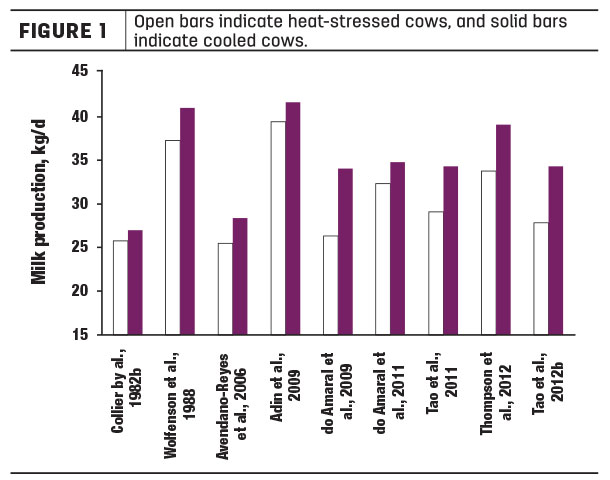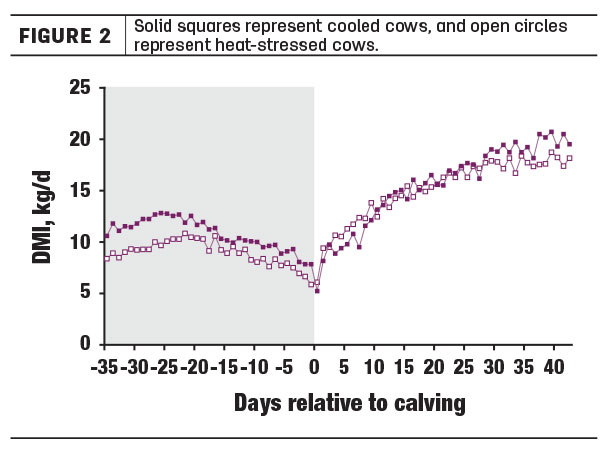Dairy producers are aware of the negative implications heat stress can have on the lactating cow. However, the often-forgotten dry cow can also experience heat stress. This leads to several serious and long-term impacts on the cow’s overall health and productivity – and ultimately, dairy farm profits. Over the past decade, several university researchers have invested a great deal of time to further identify potential losses due to heat-stressed cows.
• Reduced milk production in the subsequent lactation: Research has shown there is a carryover effect of heat stress and decreased dry matter intake on dry cows in their subsequent lactation. Herds producing 55 to 90 pounds of milk will consistently produce more milk if cows are cooled during the dry period when compared to heat-stressed non-cooled dry cows with reduced intakes. Several studies have found cooling cows during the entire dry period will allow for greater production following calving when compared to heat-stressed dry cows (Figure 1). Across the eight studies shown here, cooled dry cows produced approximately 10 pounds more milk per day than their heat-stressed counterparts in the subsequent lactation.

• Reduced dry matter intake: Dry matter intake is also significantly reduced throughout the dry period (2 pounds per day) in heat-stressed dry cows, as seen in Figure 2. Intakes generally bounce back if the cows are cooled after calving; however, there is a trend for greater feed intakes for the cooled dry cow group. Several researchers have hypothesized the reduced intake throughout the dry period is likely one of the leading causes of the other negative implications observed in the subsequent lactation.

• Reduced health, immune function and reproductive performance: Health, immune function and reproductive performance are negatively impacted as a result of a heat-stressed dry period. Several studies have linked heat stress during the dry period to a greater incidence of mastitis, respiratory disease and retained placenta for cows in the first 60 days in milk. In addition, cows that experienced heat stress during their dry period were bred more often, had longer days to first breeding and longer days to pregnancy check in the next lactation. This suggests the effects of dry-period heat stress on fertility carry over into the next lactation.
• Reduced udder development, placental development and calf birthweight: The carryover effect of dry-period heat stress that reduced milk yield has led researchers to examine its influence on mammary growth. They found mammary cell loss was not a result of heat stress directly but of the reduced feed intake during the dry period of heat-stressed cows. Because of the reduced feed intake, bodyweight gain was minimized and, ultimately, udder development was limited, reducing production potential in the subsequent lactation. Mammary epithelial cell proliferation is greatly influenced during the dry period, with heat stress severely stunting milk production potential post-calving. Placental development is also negatively influenced due to decreased blood flow during the heat-stressed dry period. Studies have shown heat-stressed dry cows typically have shorter gestation periods which, in addition to decreased placental blood flow, have led to decreased calf birthweights. Reduced feed intake during the dry period likely contributes to the lower birthweight as well.
Countering heat stress
Proper evaporative cooling systems are by far the most effective management means to controlling heat stress in dairy cattle. Housing dry cows in barns equipped with sprinklers, fans and shade results in increased milk production and improved immune response during the subsequent lactation.
Other management options to reduce the impact of heat stress on cattle:
- Extra emphasis on clean and abundant water and stalls in the summer months
- Feeding during cooler periods of the day to minimize heating of TMR
- Making sure animals have access to shade
Dietary adjustments to reduce the impact of heat stress on dry cows:
- Adjusting rations to optimize electrolytes, yeast, direct-fed microbials, organic trace minerals and other ingredients to aid in heat stress tolerance
- Building a ration to maximize rumen health, allowing cows to quickly recover dry matter intake when heat stress subsides
- Supplementing monensin to increase glucose availability and stabilize rumen pH

References omitted but are available upon request. Click here to email an editor.
This originally appeared in Hubbard Feeds’ enewsletter, Dairy Solutions.
Dr. Jon Pretz is a dairy nutritionist for Hubbard Feeds.






